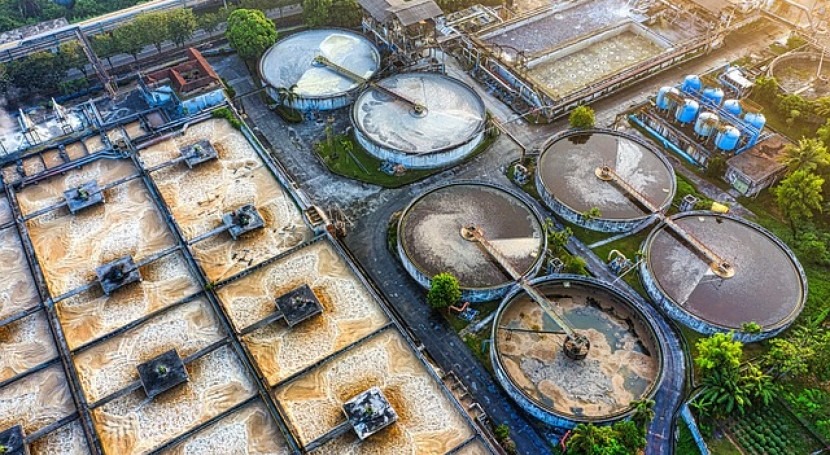Important Steps in Municipal Waste Water Treatment Plants
Important Steps in Municipal Waste Water Treatment Plants
Blog Article
Strategic Approaches to Improve Drainage Therapy Efficiency and Lessen Environmental Impact
In the world of drainage treatment, the mission for enhanced efficiency and lowered environmental impact is a continuous challenge that demands tactical remedies. As culture grapples with the crucial to take care of water resources sustainably, a nuanced technique comes to be crucial. The integration of innovative treatment innovations, energy-efficient procedures, resource recovery techniques, boosted nutrient removal methods, and wise tracking and control systems represents a complex framework for dealing with these pressing issues. What lies at the core of this facility web of methods is the prospective to revolutionize the means we approach waste water treatment, not simply as a process of disposal, but as a beneficial opportunity for advancement and environmental stewardship.
Advanced Therapy Technologies
Cutting-edge membrane filtration systems have actually revolutionized innovative wastewater treatment processes, dramatically enhancing the removal of pollutants. This technology has actually proven to be highly effective in getting rid of a broad range of pollutants, including pharmaceuticals, heavy steels, and natural substances, which are usually testing to remove with typical treatment approaches.
Moreover, membrane filtering systems supply various benefits over standard therapy approaches. In addition, these systems are highly versatile and can be conveniently incorporated right into existing therapy plants or made use of as standalone systems for decentralized applications.
Energy-Efficient Processes
The integration of energy-efficient procedures in wastewater therapy systems is essential for enhancing resource utilization and lowering functional prices. By executing energy-efficient innovations, treatment plants can substantially lower their carbon footprint and general ecological impact. One vital strategy to improving power effectiveness in wastewater therapy is the utilization of advanced aeration systems, such as great bubble diffusers or surface area aerators, which can improve oxygen transfer effectiveness and reduce power consumption. Furthermore, integrating energy recuperation systems, like anaerobic digestion for biogas manufacturing or making use of excess warm for thermal procedures, can help offset energy requirements and promote sustainability.
Additionally, optimizing process control and automation with making use of sophisticated sensing units and checking systems can boost general energy effectiveness by adjusting operations in real-time based on real demand and conditions. Executing power audits and consistently keeping track of energy efficiency indications are crucial practices to identify locations for renovation and track energy-saving initiatives properly. Overall, the adoption of energy-efficient procedures in wastewater therapy not just benefits the setting yet additionally contributes to long-term cost savings and operational sustainability.
Resource Recovery Techniques
With an emphasis on optimizing source utilization and sustainability in wastewater therapy systems, the application of resource healing strategies arises as a crucial element in boosting operational performance. Resource recovery methods in wastewater therapy entail the recognition and removal of useful sources from the waste stream, thereby transforming what was as soon as thought about waste right into a beneficial asset. By applying resource recovery methods such as nutrient elimination and recovery, power generation from natural issue, and the manufacturing of reusable water, wastewater therapy plants can lessen ecological impact while optimizing effectiveness.

Boosted Nutrient Elimination Strategies
Executing Your Domain Name sophisticated nutrient removal strategies is important for enhancing the effectiveness of wastewater treatment systems. Improved nutrient elimination plays an important function in minimizing the ecological influence of cured effluent discharged right into water bodies. Among the key techniques made use of for improved nutrient removal is the procedure of organic nutrient removal (BNR), which involves the removal of nitrogen and phosphorus with biological processes. This can be accomplished through using specialized microbes that can transform nitrogen compounds into inert nitrogen gas via denitrification, and accumulate phosphorus within their cells through a process called boosted organic phosphorus elimination (EBPR)

In enhancement to BNR, progressed therapy techniques such as membrane layer bioreactors (MBRs) and created marshes can likewise be used to improve nutrient elimination effectiveness. By incorporating these sophisticated nutrient removal techniques right into wastewater treatment systems, municipalities and industries can efficiently reduce nutrient pollution and shield the environment.
Smart Surveillance and Control Equipment
Making use of innovative modern technology, the assimilation of smart surveillance and control systems transforms the functional performance of wastewater therapy centers. These systems integrate advanced sensors and data analytics to constantly monitor key criteria such as pH degrees, turbidity, dissolved oxygen, and circulation prices in real-time. By gathering and assessing this information, operators can obtain beneficial understandings into the performance of the therapy processes, allowing aggressive adjustments to enhance treatment effectiveness.
Smart monitoring and control systems also support remote monitoring abilities, permitting drivers to gain access to real-time information and control features from off-site areas. This remote accessibility improves functional flexibility and responsiveness, allowing swift interventions in instance of system malfunctions or fluctuations in influent top quality. The predictive maintenance capabilities find out here now of these systems help stop tools failures and reduce downtime, inevitably improving the overall dependability of wastewater therapy procedures.
Conclusion
In final thought, strategic methods such as sophisticated therapy innovations, energy-efficient procedures, source recuperation methods, improved nutrient elimination methods, and clever tracking and control systems play an essential function in improving wastewater therapy effectiveness and decreasing ecological impact. By applying these methods, wastewater therapy plants can boost their general performance, decrease power usage, recuperate useful sources, and make sure conformity with ecological guidelines. These strategies are vital for efficient and sustainable wastewater administration methods.

In final thought, calculated strategies such as advanced therapy innovations, energy-efficient procedures, source recovery methods, improved nutrient removal strategies, and clever monitoring and control systems play a vital role in improving wastewater therapy efficiency and lessening environmental impact.
Report this page